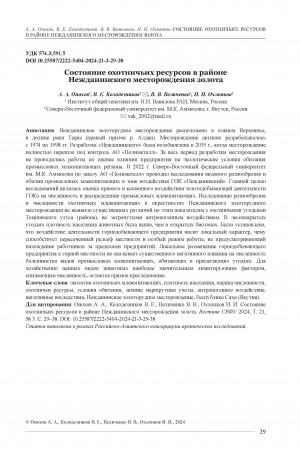Место работы автора, адрес/электронная почта: Северо-Восточный федеральный университет им. М. К. Аммосова, Институт естественных наук ; 677013, г. Якутск, ул. Кулаковского, 48, каб. 235 ; e-mail: ve.kolodeznikov@s-vfu.ru ; https://www.s-vfu.ru/
Ученая степень, ученое звание: канд. биол. наук
Область научных интересов: Зоогеография, антропогенное воздействие на экосистемы, зоология, физиология животных, радиационная биология
ID Автора: SPIN-код: 2096-7769, РИНЦ AuthorID: 118622
Количество страниц: 15 с.
The moss-biomonitor method was used for the first time to estimate the areal of precipitation extent of heavy metals and other trace elements (Al, Ba, Cd, Co, Cr, Cu, Fe, Mn, Ni, P, Pb, S, Sr, Sb, V, Zn and Hg) in the territory surrounding the landfill of domestic (communal) waste on the 9th km of the Vilyuisky tract in Yakutsk within a radius of 150 km, using the method of optical emission spectrometry with inductively coupled plasma. At the same time, mosses, lichens and soil were analysed for the content of radionuclides (40К, 137Cs, 212 Pb, 214Pb, 212Bi, 214Bi, 208Tl, 7Be, 228Ac) in a number of samples taken by semiconductor gamma spectrometry. The results of the study of moss samples by optical emission spectrometry with inductively coupled plasma indicate the presence of a large amount of toxic paper (Ba) and metal debris (Al, Co, Cr, Fe, S, Pb) in the landfill. In addition, it was shown that the following elements were found in the studied samples: Cd, Co, Cr, Cu, Mn, Ni, Pb, Sr, V, Zn, Hg. Gamma-ray spectrometry revealed that radioactive elements such as caesium 137Cs, daughter products of uranium 238U and thorium 232Th are present in the studied samples. Detection of the same heavy metals and radionuclides in the atmospheric environment and town soil (data from the scientific and technical report “Origin and composition of dust on the territory of the Municipal Entity of Yakutsk”), as well as in vegetation and soil near the landfill (data presented in this paper) may indicate that one of the sources of environmental contamination may be the products of combustion resulting of the landfill contents at the 9th km of the Vilyuisky tract.
Оценка ареала выпадения тяжелых металлов и радионуклидов на окружающую среду полигона бытовых отходов на 9-м км Вилюйского тракта в г. Якутске / С. Н. Мамаева, М. В. Фронтасьева, К. А. Петрова, В. Е. Колодезников [и др.] ; Cеверо-Восточный федеральный университет им. М. К. Аммосова, Объединенный институт ядерных исследований // Вестник Северо-Восточного федерального университета им. М. К. Аммосова. - 2024. - Т. 21, N 4 (98). - С. 7-21. - DOI: 10.25587/2222-5404-2024-21-4-7-21
DOI: 10.25587/2222-5404-2024-21-4-7-21
Количество страниц: 10 с.
The Nezhdaninskoye gold deposit is located in southern Verkhoyansk, in the valley of the Tyra River (the right tributary of the Aldan River). The field was actively developed from 1974 to 1998. Development of Nezhdaninskoye was resumed in 2019, when the field completely came under the control of Polymetal JSC. During the entire period of development of the field, no work was carried out to assess the impact of the enterprise on the environmental conditions of the habitat of commercial mammals in the region. In 2022, M.K. Ammosov North-Eastern Federal University, commissioned by Polymetal JSC, conducted research on the species diversity and abundance of commercial mammals in the area affected by the Nezhdaninsky mining and processing complex. The main тarget of the research was to assess the direct and indirect impact of gold mining activities on the number and distribution of commercial mammals. A study of the diversity and abundance of hunting mammals in the vicinity of the Nezhdaninsky gold deposit did not reveal significant differences in these indicators with the hunting grounds of the Tomponsky ulus (district) not affected by anthropogenic impact. In forested areas, the animal population density was higher than in open biotopes. It was found that the impact of the activities of the mining enterprise is local in nature, which is facilitated by the rugged terrain and a special operating mode that does not require workers to be outside the enterprise. The location of a mining enterprise does not have a significant negative impact on the number of most species of game animals living in adjacent areas. For economically valuable animal species, direct persecution remains a more significant limiting factor reducing numbers.
Состояние охотничьих ресурсов в районе Нежданинского месторождения золота / А. А. Онохов, В. Е. Колодезников, В. В. Величенко, И. И. Охлопков ; Институт общей генетики им. Н. И. Вавилова РАН, Северо-Восточный федеральный университет им. М. К. Аммосова // Вестник Северо-Восточного федерального университета им. М. К. Аммосова. - 2024. - Т. 21, N 3 (97). - С. 29-38. - DOI: 10.25587/2222-5404-2024-21-3-29-38
DOI: 10.25587/2222-5404-2024-21-3-29-38


